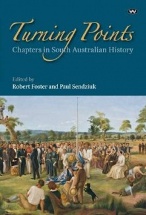Turning points ; chapters in South Australian history edited by Robert Foster and Paul Sendziuk

Wakefield Press, 2012. ISBN 9781743051191.
What did I expect from this book before I read it? A different
opinion on South Australian history. I had read several textbooks,
fictional accounts, and even early settlers diaries. I was
pleasantly surprised when the introduction informed me that this
book was a selection of public lectures, given originally in 2011.
Each author writes addressing the theme "Turning points in South
Australian history". Thus we have chapters varying in style from
standard scholarly histories, to more free form reflections on
topics they chose. This makes this book much easier to digest, with
each piece having its own flavour.
After the introduction by the editors, each chapter follows on the
previous in time. We start with "The Adelaide district in 1836'' by
Bill Gammage. This is a well illustrated synthesis of his book "The
biggest estate on Earth" in which he argues that the Aboriginal
people managed their environment to create that parklike landscape
which the colonists found in 1836. The next chapter by Henry
Reynolds investigates the issues of the 1830s, namely the policy
towards the Indigenous people. He says 'My suggestion is that South
Australia lay, in a figurative sense, between Van Diemen's Land and
New Zealand in the way it would deal with these questions of policy
towards property rights and whether the indigenous people had human
rights in a modern sense.' The chapter by Paul Sendziuk was very
interesting in that he exposes the convict element in South
Australia, in 'No convicts here: South Australia's Foundation myth'.
Chapters 5 and 6 were very politically oriented. Chapters 7 and
8 were the authors' personal histories about their families and where
they lived. Chapter 9 About the Don Dunstan era made me think back
to that time of social democracy with some fondness. The last
chapter by John Hirst is a reflection on South Australia. He ends
with 'I began with South Australia as a distinctive colony and ended
by describing it as a small state. But under the leadership of
Playford and Dunstan South Australia punched well above its weight.
I hope it can find ways to keep that tradition alive.' A book to be
dipped into if the topic interests the reader.
Giselda Grunwald